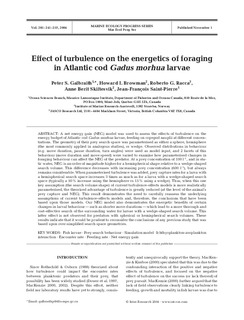| dc.description.abstract | A net energy gain (NEG) model was used to assess the effects of turbulence on the energy budget of Atlantic cod Gadus morhua larvae, feeding on copepod nauplii at different concentrations. The geometry of their prey search space was parameterised as either a sphere, hemisphere (the most commonly applied in analogous studies), or wedge. Observed distributions in behaviour (e.g. move duration, pause duration, turn angles) were used as model input, and 2 facets of this behaviour (move duration and move speed) were varied to examine how parameterised changes in foraging behaviour can affect the NEG of the predator. At a prey concentration of 100 l-1, and in static water, NEG is an order of magnitude higher for a hemispherical shape relative to a wedge-shaped search volume. This difference decreases with increasing prey concentration (600 l-1), but always remains considerable. When parameterised turbulence was added, prey capture rates for a larva with a hemispherical search space increases 3 times as much as for a larva with a wedge-shaped search space (typically a 50% increase using the hemisphere vs 15% using a wedge). Thus, when this one key assumption (the search volume shape) of current turbulence-effects models is more realistically parameterised, the theorized advantage of turbulence is greatly reduced (at the level of the animal’s prey capture and NEG). This result demonstrates the need to carefully reassess the underlying assumptions of current turbulence-effects models and, therefore, the conclusions that have been based upon those models. Our NEG model also demonstrates the energetic benefits of certain changes in larval behaviour—such as shorter move durations—which lead to a more thorough and cost-effective search of the surrounding water for larvae with a wedge-shaped search volume. This latter effect is not observed for predators with spherical or hemispherical search volumes. These results indicate that it would be prudent to reconsider the conclusions of any previous study that was based upon over-simplified search space geometries. | no_NO |
